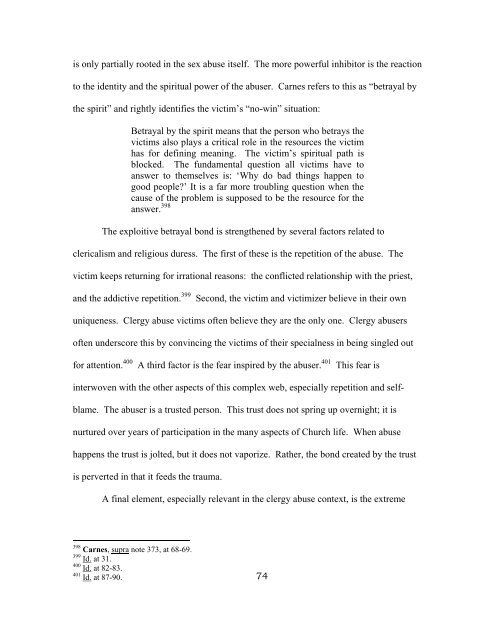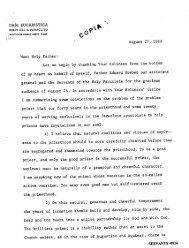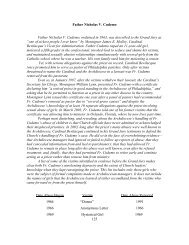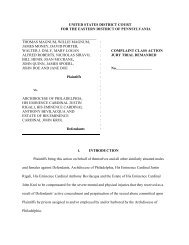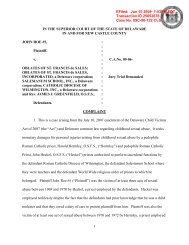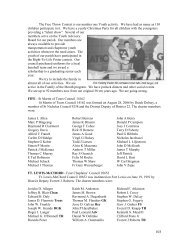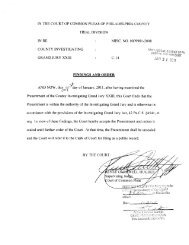1 1 Catholic Clergy Sexual Abuse Meets the Civil Law by Thomas P ...
1 1 Catholic Clergy Sexual Abuse Meets the Civil Law by Thomas P ...
1 1 Catholic Clergy Sexual Abuse Meets the Civil Law by Thomas P ...
Create successful ePaper yourself
Turn your PDF publications into a flip-book with our unique Google optimized e-Paper software.
is only partially rooted in <strong>the</strong> sex abuse itself. The more powerful inhibitor is <strong>the</strong> reaction<br />
to <strong>the</strong> identity and <strong>the</strong> spiritual power of <strong>the</strong> abuser. Carnes refers to this as “betrayal <strong>by</strong><br />
<strong>the</strong> spirit” and rightly identifies <strong>the</strong> victim’s “no-win” situation:<br />
Betrayal <strong>by</strong> <strong>the</strong> spirit means that <strong>the</strong> person who betrays <strong>the</strong><br />
victims also plays a critical role in <strong>the</strong> resources <strong>the</strong> victim<br />
has for defining meaning. The victim’s spiritual path is<br />
blocked. The fundamental question all victims have to<br />
answer to <strong>the</strong>mselves is: ‘Why do bad things happen to<br />
good people?’ It is a far more troubling question when <strong>the</strong><br />
cause of <strong>the</strong> problem is supposed to be <strong>the</strong> resource for <strong>the</strong><br />
answer. 398<br />
The exploitive betrayal bond is streng<strong>the</strong>ned <strong>by</strong> several factors related to<br />
clericalism and religious duress. The first of <strong>the</strong>se is <strong>the</strong> repetition of <strong>the</strong> abuse. The<br />
victim keeps returning for irrational reasons: <strong>the</strong> conflicted relationship with <strong>the</strong> priest,<br />
and <strong>the</strong> addictive repetition. 399 Second, <strong>the</strong> victim and victimizer believe in <strong>the</strong>ir own<br />
uniqueness. <strong>Clergy</strong> abuse victims often believe <strong>the</strong>y are <strong>the</strong> only one. <strong>Clergy</strong> abusers<br />
often underscore this <strong>by</strong> convincing <strong>the</strong> victims of <strong>the</strong>ir specialness in being singled out<br />
for attention. 400 A third factor is <strong>the</strong> fear inspired <strong>by</strong> <strong>the</strong> abuser. 401 This fear is<br />
interwoven with <strong>the</strong> o<strong>the</strong>r aspects of this complex web, especially repetition and self-<br />
blame. The abuser is a trusted person. This trust does not spring up overnight; it is<br />
nurtured over years of participation in <strong>the</strong> many aspects of Church life. When abuse<br />
happens <strong>the</strong> trust is jolted, but it does not vaporize. Ra<strong>the</strong>r, <strong>the</strong> bond created <strong>by</strong> <strong>the</strong> trust<br />
is perverted in that it feeds <strong>the</strong> trauma.<br />
A final element, especially relevant in <strong>the</strong> clergy abuse context, is <strong>the</strong> extreme<br />
398<br />
Carnes, supra note 373, at 68-69.<br />
399<br />
Id. at 31.<br />
400<br />
Id. at 82-83.<br />
401<br />
Id. at 87-90.<br />
74


